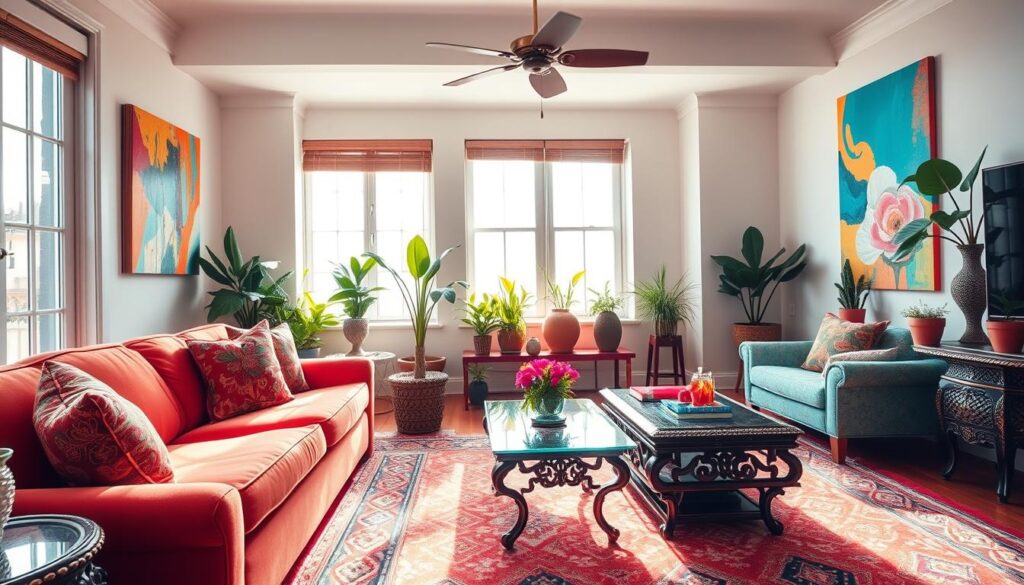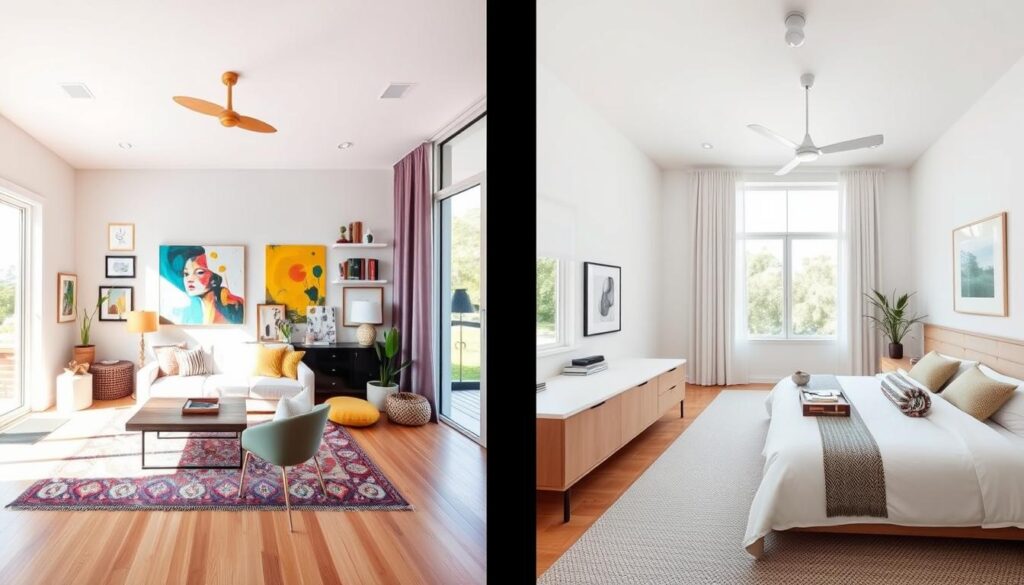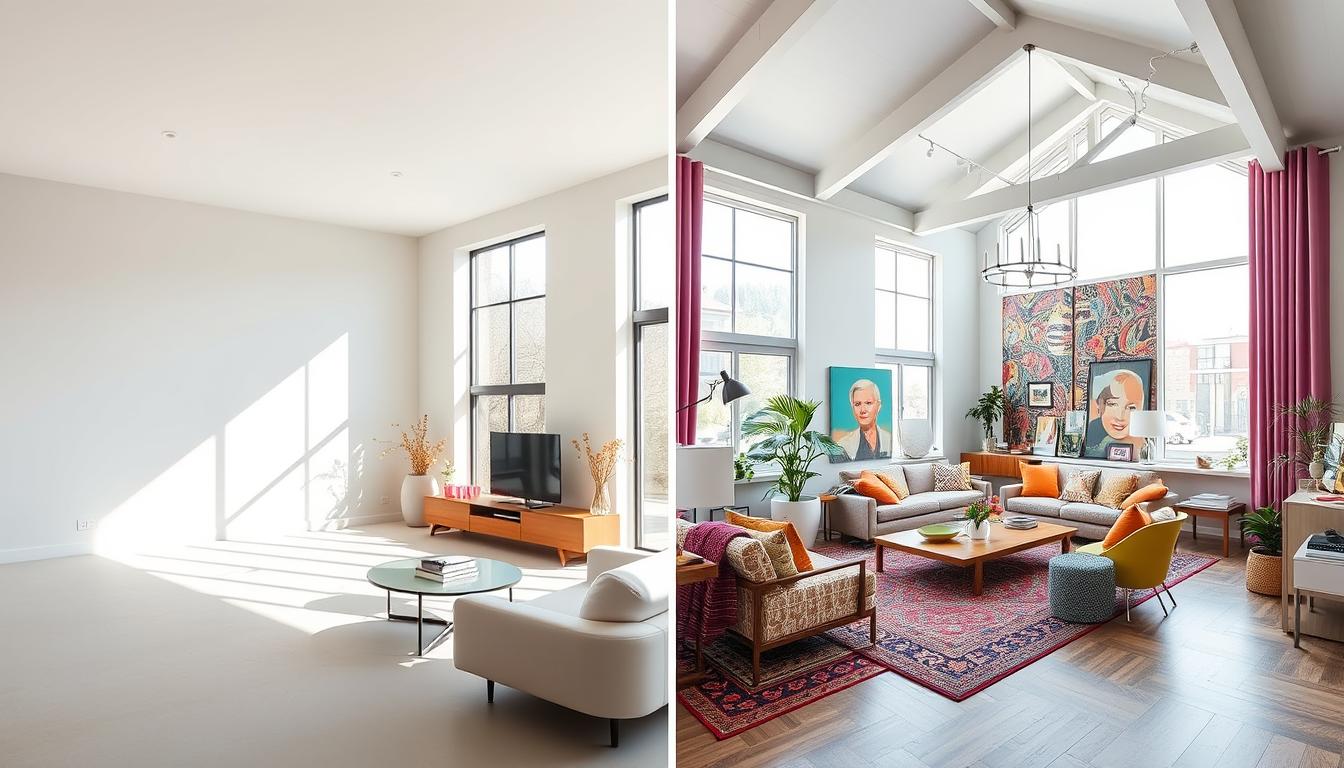Your home is more than just walls and furniture—it’s a reflection of your emotions. The way you design your space can influence your mood, energy, and even long-term happiness. Two popular styles dominate today’s trends: one bursting with colors and patterns, the other embracing calm simplicity.
Research shows that our surroundings trigger emotional responses. Bright, lively designs may spark joy, while clean, uncluttered spaces promote relaxation. But which approach truly enhances well-being? The answer isn’t one-size-fits-all.
Consider the rise of bold, expressive interiors on social media alongside the timeless appeal of minimalist aesthetics. Both have passionate followers. Your choice depends on whether you thrive in energetic environments or prefer serene retreats.
Key Takeaways
- Your surroundings directly impact your emotions and daily happiness.
- Vibrant designs energize, while minimalist spaces encourage calm.
- Trends favor both styles, making personal preference key.
- Social media showcases the popularity of bold and simple aesthetics.
- The right balance depends on your lifestyle and emotional needs.
What Is Dopamine Decor? The Joy-First Design Trend
Bright hues and cozy textures aren’t just pretty—they’re happiness boosters. This design trend, often called joy-first styling, focuses on creating spaces that spark joy through sensory-rich elements. Think bold colors, plush fabrics, and playful patterns that make you grin the moment you walk in.

Core Principles of Dopamine Decor
At its heart, this style leans into color psychology. Sunny yellows energize, while deep blues calm. Pantone’s 2025 forecasts predict a shift toward brighter, more expressive hues, moving away from traditional neutrals.
Texture plays a starring role too. Layering chunky knit throws with silky satin pillows adds depth and tactile appeal. As one designer notes,
“It’s about creating a space that feels like a warm hug.”
How Color and Texture Trigger Happiness
Lighting is key. Natural light amplifies vibrant walls, while smart bulbs (like Philips Hue) let you adjust warmth for mood. Pair this with nostalgic touches—retro toys or a gallery wall—to evoke positive memories.
Functionality meets fun with colorful organizers or mixed patterns. The Boahaus “Dopamine Delights” collection showcases how zigzag rugs can harmonize with floral wallpaper without overwhelming a room.
What Is Minimalism? The Power of Less
Minimalism isn’t about lack—it’s about purposeful choices. Rooted in Zen philosophy and Scandinavian design, this style strips away excess to highlight what truly matters. Think open spaces, natural materials, and a focus on functionality.

Key Tenets of Minimalist Design
The 20/80 rule guides minimalist spaces: keep only the 20% of items you use 80% of the time. Brands like Muji champion hidden storage, while IKEA offers modular solutions. Compare their approaches:
| Feature | Muji | IKEA |
|---|---|---|
| Materials | Linen, unfinished wood | Plywood, recycled plastic |
| Storage Style | Seamless compartments | Visible organizers |
| Color Palette | Earthy neutrals | White and soft grays |
Tactile textures—matte finishes, raw edges—add warmth without clutter. Boahaus vanities showcase how monochromatic layouts feel inviting.
The Psychological Benefits of Simplicity
A Johns Hopkins study found clutter raises cortisol levels by 15%. Minimalism counters this with calm, neutral palettes and fewer distractions. Marie Kondo’s “spark joy” method aligns here: keep only what serves you.
Natural light and raw materials like stone deepen the serenity. As one designer notes:
“Minimalism isn’t empty—it’s curated freedom.”
Dopamine Decor vs Minimalism: Mood and Emotional Impact
The way we design our surroundings directly influences our brain chemistry and emotional well-being. Vibrant hues and clutter-free spaces don’t just look different—they feel different, triggering unique neurological responses. Let’s explore the science behind why one energizes your mood, while the other melts away stress.
Science Behind Color and Happiness
fMRI scans show that chromatic variety activates the ventral tegmental area, a brain region linked to pleasure. Warm lighting (like 2700K bulbs) boosts oxytocin, enhancing feelings of connection. A 2025 UCLA study compared teens in maximalist rooms with seniors in minimalist spaces:
| Group | Brain Activity | Emotional Response |
|---|---|---|
| Maximalist teens | High dopamine spikes | Instant excitement |
| Minimalist seniors | Steady serotonin | Lasting contentment |

Sound also plays a role. Echoes in sparse rooms increase alertness, while textured fabrics absorb noise for calm. As one neuroscientist notes:
“Your space is a mood remote control—bright for energy, muted for relaxation.”
Why Less Clutter Means Less Stress
Clutter raises cortisol levels by 17%, per a Johns Hopkins study. Minimalist designs reduce cognitive load, quieting the default mode network—the brain’s “overthinking” zone. Headspace’s offices use this principle:
- Biophilic elements (plants, wood) lower heart rates.
- Blue accents—linked to tranquility—dominate their meditation pods.
- Hidden storage eliminates visual distractions.
Whether you crave joy or serenity, your design choices shape daily emotions. The key? Align your space with how you want to feel.
Practical Pros and Cons of Each Style
Every design style has trade-offs, from vibrant excitement to peaceful restraint. Whether you crave energy or tranquility, understanding the practical upsides and downsides helps you craft a space that works for your lifestyle.

Dopamine Decor: Vibrancy vs Overstimulation
Bold colors and playful textures ignite joy, but they’re not for everyone. A 2025 study found 68% of people feel overwhelmed by this style in small spaces. Here’s what to weigh:
- Cost: Frequent updates (seasonal pillows, statement art) add up faster than timeless minimalist furniture.
- Maintenance: Dust clings to velvet and fringe, while glossy minimalist surfaces show fingerprints.
- ADHD-friendly: Color-coded zones boost focus, but clutter can backfire.
“Balance high-energy elements with neutral anchors—like a bright rug on hardwood floors.”
Minimalism: Calm vs Sterility
Clean lines promote calm, yet going too sparse can feel cold. Critics call this the “hospital effect.” Consider these factors:
- Resale value: Zillow reports neutral, clutter-free homes sell 10% faster, but bold accents can attract niche buyers.
- Pet-proofing: Leather resists scratches (unlike velvet), but scratches on minimalist surfaces stand out.
- Hybrid fixes: Colorful storage boxes blend joy with order, dodging “sad beige” memes.
Renters face unique challenges—wallpaper peels vs. strict no-drill policies. The key? Adapt core principles to your limits.
Can You Blend Dopamine Decor and Minimalism?
Why choose one style when you can harmonize the best of both worlds? A 2025 survey reveals 72% of millennials prefer hybrid design, merging vibrant energy with tranquil simplicity. This fusion, dubbed “midimalism,” lets you curate spaces that spark joy and soothe stress.

The Rise of Midimalism
Midimalism balances bold accent pieces with clean foundations. Think neutral walls paired with a single emerald-green sofa or a minimalist desk topped with a rainbow organizer. Follow the 5:1 ratio—five calm elements for every one vibrant pop.
| Style | Midimalist Solution | Effect |
|---|---|---|
| Dopamine decor | Peel-and-stick wallpaper behind beds | Removable joy |
| Minimalism | Boahaus drawers with hidden teal interiors | Surprise color |
Tips for a Balanced Approach
- Zone it: Keep workspaces minimalist but add playful art in relaxation areas.
- Budget hacks: Paint drawer liners or add LED strips under shelves for glow.
- Avoid clashes: Pair geometric rugs with solid curtains, not competing prints.
“Command Hooks let renters test bold art without commitment—perfect for midimalist experiments.”
This balanced approach adapts to any lifestyle. Whether you crave energy or calm, midimalism tailors your space to uplift and unwind.
Choosing What Works for You: Personalization Is Key
Designing a space that truly fits your personality starts with understanding what makes you feel good. Your home should amplify joy, whether through vibrant accents or serene simplicity. The best design isn’t about rules—it’s about your emotional response.

Assessing Your Emotional Needs
Ask yourself: Does clutter stress you out, or do bold colors energize you? A quick 10-question quiz like “Which Style Matches Your Brain?” can reveal your preferences. Audit daily routines too—high-traffic areas might need calming neutrals, while hobby spaces crave creativity.
Mood boards (Pinterest or Canva) help visualize blends. One Reddit user shared:
“I mixed my grandma’s quilt with a minimalist desk—now my office feels cozy and focused.”
Small Changes for Big Impact
Start subtle. Swap pillowcases for colorful ones or layer scents (like First Source candles) to uplift moods. Replace mass-produced art with framed photos of cherished memories.
- Sentimental items: A childhood toy on a shelf adds belonging.
- Cultural hues: Mediterranean blues soothe, while fiery reds energize.
- Functional joy: Use rainbow bins to organize while sparking happiness.
Your space should tell your story. Whether through vibrant personal touches or quiet minimalism, the goal is the same: a home that makes you happy.
Conclusion: Happiness Lives in Your Design Choices
Joyful spaces or peaceful retreats—your home should reflect what lifts you. There’s no universal “best” style. Extroverts may thrive with vibrant dopamine decor, while introverts often prefer calm, minimalist havens.
Experiment fearlessly. Try removable wallpaper or a bold cushion—like Boahaus’s sunny yellow pick—to test what sparks joy. Trends cycle, but your happiness is timeless.
Ready to transform your space? Explore playful yet intentional designs that balance energy and serenity. Start small today. After all, great design begins with your choices.

